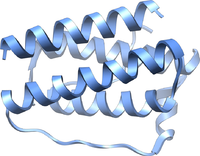
Photo from wikipedia
Introduction Parathyroid tumours are the second most common endocrine neoplasia in women, after thyroid cancer. Mutations in the oncosuppressor CDC73 are the key event in most carcinomas whereas alterations in… Click to show full abstract
Introduction Parathyroid tumours are the second most common endocrine neoplasia in women, after thyroid cancer. Mutations in the oncosuppressor CDC73 are the key event in most carcinomas whereas alterations in the tumour suppressor MEN1 (located at 11q13.1) occur in up to a third of sporadic adenomas. Although lncRNAs play a regulatory role in endocrine cancer pathogenesis, a lncRNAs profiling in human parathyroid tumours is still missing. Here, we identified a ‘molecular signature’ able to distinguish among parathyroid histotypes and a new potential epigenetic role of MEN1 in lncRNAs regulation. Material and methods Ninety lncRNAs were investigated in 4 parathyroid carcinomas (PCas), 12 adenomas (PAds) and 2 normal glands (PaNs). Hierarchical clustering (HCL) and Significance Analysis of Microarray (SAM) were performed to identify differences in lncRNAs expression. Significant lncRNAs were validated in additional 7 PCas, 26 PAds, 6 atypical PAds (aPAds) and 4 PaNs. CDC73 and MEN1 genes mutations were detected by Sanger sequencing. PAds genomic characterisation was obtained by array Comparative Genomic Hybridization (aCGH). HEK293 cells were transiently silenced for MEN1 expression to analyse MEN1-lncRNAs correlation. Results and discussions Nine lncRNAs were identified as differentially expressed in parathyroid tissues. Specifically, KCNQ1OT1 and SNHG6 were enriched in PaNs, reduced HAR1B, MEG3, HOXA3as and NEAT1 expression characterised PAds, whereas BC200, HOXA6as and WT1-AS were upregulated in PCas. HCL identified 3 clusters in which PaNs and PCas were distinctly separated, while aPAds were closer to PCas. Moreover, PAds clustered in a highly heterogeneous way. Notably, PCas and aPAds harbouring CDC73-mutations overexpressed the majority of the lncRNAs, compared to CDC73 wild-type samples. Interestingly, BACE1-AS, KCNQ1OT1, NEAT1 and SNHG6 levels in PAds were positively correlated with MEN1 levels. aCGH analysis revealed that Chr11 loss of heterozygosity (LOH) was the main chromosomal aberration in PAds. Of note, Chr11 LOH was associated with significant HAR1B upregulation and these data were confirmed in HEK293 cells knocked-down for MEN1. Conclusion Parathyroid histotypes are characterised by different lncRNAs signatures, suggesting a correlation with tumour aggressiveness and pathogenetic mechanisms. Further, our data highlight that lncRNAs profiles are related to CDC73 gene mutation status, chromosome 11 derangements and MEN1 inactivation.
Journal Title: ESMO Open
Year Published: 2018
Link to full text (if available)
Share on Social Media: Sign Up to like & get
recommendations!